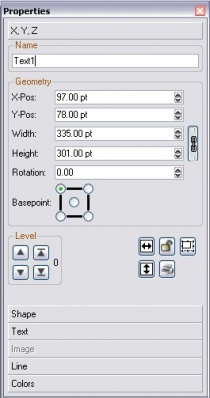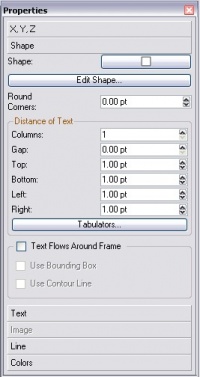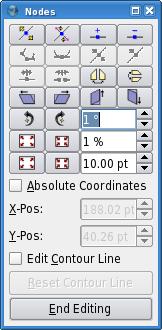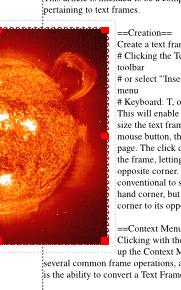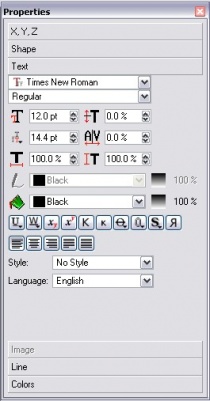Arbeiten mit Textrahmen
| Installation • Anwendungsfragen • PDF-Export • DTP • Sonstiges |
Übersetzung im Gange
Dieser Artikel soll die Opereationen beschreiben, die mit Textrahmen möglich sind.
Erstellen
Ein Textrahmen kann auf mehrere Arten erstellt werden:
- Klicken auf das Textrahmen einfügen-Symbol in der Werkzeugleiste
- oder über das Menü Einfügen > Text Rahmen
- Mittels Tastatur: T, oder Alt+N, T.
Mit der Maus kann der Text Rahmen plaziert und in der Größe angepaßt werden. Halten Sie die linke Maustaste gedrückt und ziehen Sie den Rahmen diagonal über die Seite auf. Der Klick legt die eine Ecke des Textrahmens fest, die gegenüberliegende Ecke ergibt sich, wenn Sie die Maustaste loslassen. Gewöhnlich sollten Sie mit der linken oberen Ecke anfangen. Scribus erlaubt es aber auch, mit jeder beliebigen Ecke anzufangen.
Löschen
Ein ausgewählter Rahmen kann durch Drücken der Entfernen-Taste gelöscht werden. Die Tastenkombination Ctrl+X schneidet den Rahmen aus und hält ihn in der Zwischenablage vor.
Kontextmenü
Ein Klick mit der rechten Maustaste auf einen Rahmen öffnet dessen Kontextmenü. Hier finden sich einge der gebräuchlichsten Funktionen, so z.B. auch die Möglichekeit, einen Textrahmen in einen anderen Rahmentyp umzuwandeln.
Größe und Position
Sie werden feststellen, daß der Eigenschaftendialog ein unverzichtbares Werkzeug in Scribus ist. Wenn er nicht schon geöffnet ist, öffnen Sie ihn über das Menü Fenster > Eigenschaften. In Scribus 1.2.x findet sich dieser Punkt unter Werkzeuge > Eigenschaften. Der XYZ-Reiter des Eigenschaftendialogs zeigt sehr präzise die Position der linken oberen Ecke des aktuell ausgewählten Rahmens auf der Seite an. Hier finden sich auch Höhe, Breite sowie der Rotationswinkel des Rahmens. Beachten Sie, daß diese Informationen nur für den aktuell markierten Rahmen angezeigt werden. Direkt nach Erstellung eines Rahmens ist dieser immer ausgewählt, sichtbar duch die gestrichelte rote Linie. Ein Linksklick außerhalb des Rahmens hebt die Auswahl auf, ein Klick in den Rahmen wählt ihn wieder aus. Um einen Rahmen mittels der Eigenschaftenpalette verändern zu können, muß der entsprechende Rahmen angewählt sein.
Größe und Position ändern
Mit der Maus:
- Klicken Sie an eine beliebige Stelle in den Rahmen und verschieben Sie ihn bei gedrückter Maustaste. Rahmen können auch außerhalb der Seite positioniert werden. Abhängig von der Scribus-Version ist auch ein Fluß von einer Seite auf die nächste möglich.
- Klicken Sie eines der kleinen Rechtecke in der Umrandung an und ziehen Sie mit der Maus, um die Größe des Rahmens zu verändern
Mit dem Eigenschaftendialog:
Es existieren drei Wege, um die Einstellungen eines Rahmens zu bearbeiten:
- mit der Tastatur
- Klicken Sie mit der Maus einen der auf-/ab-Pfeile rechts neben jeder Einstellung an. Die Pfeiltasten auf der Tastatur haben denselben Effekt.
- Mit dem Mausrad. Gewöhnlich reicht es aus, den Cursor über dem entsprechenden Feld zu plazieren, u.U. muß das Feld aber auch angeklickt werden.
Beachten Sie für die zweite und dritte Methode auch, daß das gleichzeitige Drücken von Ctrl, Shift oder Crl+Shift (funktioniert auch mit den Pfeil-Tasten) Einfluß auf die zu ändernde Dezimalstelle nimmt. Breite und Höhe sind im Eigenschaftendialog proportional miteinander verbunden: Eine Änderung des einen Wertes führt automatisch zu einer proportionalen Änderung des anderen. Ein Klick auf das Ketten-Icon rechts neben den Eingabefeldern hebt dieses Verhalten auf.
Weitere Tips
- Aktivieren Sie im Menü die Option Seite > Am Raster ausrichten (Verion 1.2.x: Ansicht > Am Raster ausrichten ). Ihre Rahmen werden nun am Raster der Seite ausgerichtet. Über das Menü Ansicht > Raster anzeigen können Sie das Raster der Seite ein- oder ausblenden (es erscheint weder im Druck noch im PDF-Export). Sie können das Raster über das Menü Datei > Dokument einrichten > Hilfslinien > Seitenraster einstellen.
- Der Menüpunkt Seite > An Hilfslinien ausrichten (v1.2.4: Ansicht > An Hilfslinien ausrichten) veranlaßt die Rahmen, sich an den Hilfslinien der Seite auszurichten. Der Punkt Ansicht > Hilfslinien anzeigen schaltet die Anzeige der Hilfslinien an oder aus. Genau wie das Raster auch werden Hilfslinien weder gedruckt noch beim Export in andere Dateiformate (wie PDF) berücksichtigt. Hilfslinien können entweder über Seite > Hilfslinien bearbeiten oder über Datei > Dokument einrichten > Hilfslinien hinzugefügt bzw. abgeändert werden.
HIER GEHTS WEITER
Drehen
Mit der Maus:
Aktivieren Sie das Objekt Drehen - Symbol in der Menüleiste (Tastatur: R), dann klicken Sie in den zu drehenden Rahmen und drehen Sie ihn bei gedrückter Maustaste bis zum gewünschten Winkel.
Mit dem Eigenschaften-Dialog:
Wie bei Grössen- und Positions-Änderungen, haben Sie drei Möglichkeiten die Drehung eines Rahmens zu ändern. Auf dem Reiter "X,Y,Z" finden Sie ein Rechteck mit der Bezeichnung "Ursprung". Setzen Sie hier fest, ob der Mittelpunkt oder eine der vier Ecken des Rahmens als Drehungspunkt benutzt werden soll. Den zu drehenden Winkel geben Sie in unter "Drehung" an.
Rahmen kopieren und ähnliche Operationen
There are several different ways to copy or move frames.
Es gibt mehrere Methoden, Rahmen zu kopieren oder zu bewegen.
- Sie sollten bereits vertraut sein mit den grundlegenden Operationen der Zwischenablage - Kopieren und Einfügen (Tastatur: Ctrl+C, Ctrl+V), sowie Ausschneiden und Einfügen (Tastatur: Ctrl+X, Ctrl+V). Sie finden diese Funktionen ebenfalls im Menü Bearbeiten oder im Kontext-Menü (Klick mit der rechten Maustaste). Möchten Sie einen Rahmen auf eine andere Sete bringen, kopieren oder schneiden Sie ihn aus, wechseln Sie dann zur entsprechenden Seite und fügen Sie den Rahmen hier wieder ein. Der Rahmen bekommt auf der Ziel-Seite dieselben Koordinaten wie auf der Quell-Seite.
- Die Duplizieren-Funktion: Tastatur Ctrl+Alt+Shift+D oder über das Menü Objekt > Dupilzieren. In geringem Abstand und eine Ebene höher zum Original-Rhamen wird eine Kopie erstellt.
- Sie können auch auf einen Schlag mehrere Dupliakte eines Rahmens erzeugen. Der Menüpunkt Objekt > Mehrfach Duplizieren öffnet einen Dialog, in dem Sie einstellen können, wieviele Kopien und in welchem Abstand diese zueinander erstellt werden sollen. Sie können diese Funktion auch nutzen wenn Sie nur eine Kopie, aber mit anderem Abstand zum Original erstellen wollen. Beachten Sie, dass ein einmal hier eingestellter Abstand ab nun als Standard benutzt wird.
- Es ist ebenfalls möglich, einen Rahmen mit der rechten Maustaste zu verschieben. Lassen Sie die Maustaste los, werden Sie gefragt ob Sie den Rahmen an diese Stelle verschieben oder hier eine Kopie erstellen wollen.
- Letztendlich gibt es die Bibliothek, Objekt > In Bibliothek speichern oder über das Kontext-Menü. Dies erzeugt eine Kopie des Rahmens und seines Inhaltes in der Bibliothek. Wollen Sie auf ein Bibliotheks-Objekt zugreifen, öffnen Sie diese über Fenster > Bibliothek. Von hier können Sie beliebig viele Kopien eines gespeicherten Objekts mittels der Maus auf Ihr Dokument ziehen. Die gesamte Bibliothek kann in einer Datei gespeichert und so in anderen Scribus-Dokumenten benutzt werden.
Sie werden feststellen, dass Sie Rahmen ausserhalb der Seiten-Grenzen Ihres Dokuments ablegen können. Auch von hier können diese kopiert, dupliziert oder in sonstiger Weise manipuliert werden. Sie werden an diesen Stellen im Dokument gespeichert. Erstellen Sie eine PDF-Datei mit Elementen ausserhalb der Seiten-Grenzen, erhalten Sie Fehlermeldungen. Wenn Sie diese ignorieren, wird die PDF-Datei ohne die ausserseitigen Rahmen erstellt. Beachten Sie, dass Sie, gerade in grösseren Dokumenten, schnell den Überblick über Rahmen ausserhalb der Seitengrenzen verlieren können.
Entering/Editing Text in the Frame
Story Editor
With a text frame selected, click the Story Editor icon on the toolbar (keyboard: Ctrl+Y), or Menu item Edit > Edit Text...; this is also available in the Context Menu (right-click in frame). The Story Editor is the most efficient way to manually enter text. The text will display with the correct font color, but the font face and spacing will not be reflected in the Story Editor's display. If the font color is similar to the background color in Story Editor, you may change the background color as desired: Story Editor menu Settings > Background....
The many features of Story Editor will be covered in detail elsewhere (also see Properties: Text Tab below - layout is different but features are the same). For this brief introduction, note that a large array of text features are completely under your control in Story Editor, including font face, color, spacing, kerning, justification, and more. Note that changing a setting will only modify text that you have selected (highlighted) and any subsequently entered text.
Take the time to learn how to create and use Styles, which will save time when you are repetitively using a font with a specific set of features.
Editing from the main page
Click the Edit Contents of Frame icon on the toolbar (keyboard: E). When you click inside the frame, you will see a blinking vertical cursor where you may add or edit text. You may also select (highlight) text and change the highlighted text features in Properties > Text. As you can see the choices are analogous to those in the Story Editor.
Editing All the text in the frame
If not already selected, click the Select item icon on the toolbar (keyboard: C | note that if you are in Edit Contents of Frame mode, pressing C will enter text in the frame). Now select the frame whose text you wish to edit. At this point if you make changes in Properties: Text, all text in the frame will be modified.
Special Characters, Foreign Language Accented Characters
There is the potential ability to insert foreign language accented characters, special symbols not found on the keyboard, typographic symbols (such as typographic quotation marks, em dash, en dash, variably sized spaces, for example), and ligatures. This capability can be found either in the main menu or Story Editor menu under Insert > Glyph, Insert > Character, Insert > Quote, Insert > Spaces & Breaks, and Insert > Ligature.
- If your special character fails to display, this most often means that it is not available in your chosen font. Just because it shows in Story Editor does not mean it will show on the page.
- Also see Typography.
Loading Text from a File
Load text from a file from the Context Menu (right click in frame) > Get Text, or from the menu File > Import > Get Text. You may also Append Text (Get Text will replace whatever is already in the frame). You may also load a file into Story Editor.
There are also the special files of "lorem ipsum" text, that can most easily be accessed from the Context Menu (right-click in frame), under Sample Text (from Menu: Insert > Sample Text). Scribus has this in several language versions, in addition to Latin.
Linking One Frame to Another
Text may be continued from one frame to another, on the same page or different pages.
First make sure the first frame is selected, then click the Link Text Frames icon on the toolbar (keyboard: N), then click the second frame -- that's it. If you have a third or more frames to also link, continue clicking to continue linking further frames. Remember that the links go in the order that you click from one to the next.
Note that frames can be linked before or after they have any content.
Unlink Text Frames is operationally similar -- click the first frame, then the Unlink icon, then the frames to unlink.
Levels & Layers
Frames in general, not just text frames, represent a two-dimensional space that you manipulate and move around your workspace, much like a small note you can attach and detach. Like small physical notes, they are laid down, one by one, on the page, new ones on a layer over the previous ones. The small box labeled Level in the XYZ tab of Properties allows you to move the selected frame up or down layers; the arrows with bars will move all the way to the top or bottom. Since the background of your frame may be opaque or transparent, the level the frame is at will affect how much of the frame can be visible in relationship to other overlapping or underlying frames.
XYZ Tab: The Rest
The remaining buttons in the XYZ tab do the following:
- Flip the selected frame horizontally or vertically
- Lock a frame in place. Everything about your frame is locked -- size, position, contents. Copying and pasting a locked frame may produce unexpected results.
- Lock the size of the frame only. Note that the editing tabs disappear from the corners and sides.
- Enable/disable printing of the frame. Why? You may want to have a frame on the page that's a message to yourself or someone else, yet not be part of the printed finished work. Or the frame may just be a space-saver for some other purpose.
Properties: Shape Tab
Click the Shape tab in Properties. Near the top is a button with a square in the center. If you click that button, you may quickly switch to one of a group of set shapes from your original rectangle. In addition, if you click Edit Shape, you now have full vector-editing control of your shape.
Another angle on shapes and text frames:
You may also use the Polygon tool on the toolbar (use will be described in detail in another section) to create a regular polygon, which may then be converted using the Context Menu (right-click in the polygon) to Convert To > Text Frame. Note that before you enter text, you may want to change the background color of the frame.
Round Corners
Causes an adjustable degree of rounding of the Text Frame corners. Also note the effect of negative values.
Distance of Text
Columns, Gap: Set the number of columns inside the frame and the gap between columns.
Top, Bottom, Left, and Right adjust the space from the edge of the frame to the text inside.
Tabulators: For setting tab stops within your frame.
Text Flows Around Frame
| Use this to determine what happens with text underneath the selected frame. Remember Levels & Layers? When you create an image frame, the Bounding Box (of the image) and the Contour Line are the same size and position. But click on Edit Shape... and you can change this Contour Line's size, position, and shape as desired -- just check the box for Edit Contour Line. |
Here is an example with an image frame, but this could just as well be a text frame: |
Properties: Text Tab
The top two buttons are straightforward: font face and style. Remember that if you are in Select Item mode, as opposed to Edit Contents mode, changes in the font settings will change all the text in the frame. To modify only some of the text, switch to Edit Contents mode (keyboard: E), then highlight the text you wish to modify.
Next is a block of six requestors with number values:
- Left top is font size
- Left middle is the space between lines of text. When you are in Select Item mode, this will automatically change as you adjust font size (but can be adjusted afterward independently), in Edit Contents mode it will not. See Working with Story Editor: Font Size and Line Spacing about the different ways that font size and line spacing adjustments interact.
You may change the degree of automatic line spacing in File > Preferences > Typography. - Left bottom is the width of characters -- note that height remains constant
- Right top raises (positive values) or lowers selected characters from the baseline. This adjustment is not present in Story Editor.
- Right middle is kerning: the distance between characters
- Right bottom adjusts height of characters -- note that width remains constant, and that characters remain on the baseline.
As described above in Resizing, Repositioning, there are three ways to change these values.
There are two color buttons next, the top referring to the outline and/or shadow if selected (see below, items 8 and 9), and the bottom to the fill color. Aside from the hue, you may also adjust saturation - click on the number for a list of choices.
A row of buttons follows, so from left to right:
- Underline, including spaces between words. Adjustable line width, vertical position. No adjustments in v1.2.4
- Underline, characters only. Adjustable line width, vertical position. Not available in v1.2.4
- Subscript. You may also want or need to adjust size. For v1.2.4, adjustments are in Effects > Preferences > Typography
- Superscript. Size is separately adjusted. For v1.2.4, adjustments are in Effects > Preferences > Typography
- All caps. Applies to letters. Not available in v1.2.4
- All small caps. Letters only; sizes of other characters and capitalized letters not affected.
- Strikethrough. Line width and position adjustable. No adjustments in v1.2.4
- Adds an outline to the font, width adjustable. No adjustments in v1.2.4
- Creates a shadow, in essence a duplication of the character, just "behind" it, position adjustable. You may have both an outline and a shadow, but both will have the same color and shade. Not available in v1.2.4
- Reverse (horizontal mirror image) of selected letters.
The next row of buttons selects justification. The rightmost button forces every line to be fully justified, which can produce unexpected results.
The Style button allows for easy application of a set of font features. There are no default styles, these are user-created. See the Menu item Edit > Paragraph Styles... or Edit > Line Styles... to create a New style, or Save and Import styles.
For more on styles, see Working with Story Editor:Styles.
Lastly, the Language button chooses a language for automatic hyphenation.
Eigenschaften: Umrandung
Die Umrandung eines Text-Rahmens wird über die Linie eingestellt. Beachten Sie, dass in der Standard-Einstellung ein die Umrandung eines Rahmens keine Farbe, also unsichtbar ist. Unabhängig von den Einstellungen in den Linien-Eigenschaften wird die Umrandung des Rahmens also erst dann sichtbar, wenn eine Farbe vergeben wird.
Die verschiedenen Einstellungen für Linien sind weitestgehend selbsterklärend. Ist eine Eigenschaft grau hinterlegt, steht sie für Rahmen nicht zur Vefügung.
Eigenschaften: Farben-Reiter
Wie bereits gesagt, die Linien-Farbe steht für den Rand des Rahmens, mit der Standard-Einstellung "Keine".
Die Füllfarbe bezeichnet den Rahmen-Hintergrund. Ist hier keine angegeben, wird der Rahmen transparent dargestellt. Die Farbe des Textes kann im Text-Reiter des Eigenschaften-Dialogs oder im Story-Editor eingestellt werden.
Schatten bezeichnet die Sättigung der Farbe.0% repräsentiert einen neutralen Grauton. Deckkraft bezeichnet die relative Deckkraft/Transparenz, 100% steht für komplette Deckkraft, 0% für komplett durchsichtig. An dieser Stelle soll noch angemerkt werden, dass einige Versionen des PDF-Formats sowie einige PDF-Betrachter keine Transparenz unterstützen.
Overprinting versions 1.3.4 and above
Knockout versus Overprinting are described here.
Please note that you are not limited to colors you see displayed in the Color Tab, nor are you compelled to have all these choices. See the Menu item Edit > Colors to add, edit, or remove colors. Removing colors can simplify the use of Scribus, and does reduce saved file size.
